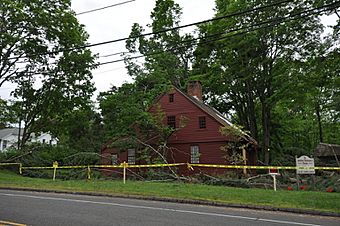Jonathan Dickerman II House facts for kids
Quick facts for kids |
|
|
Jonathan Dickerman II House
|
|

House not long after 2018 storm damage
|
|
| Location | 105 Mt. Carmel Ave., Hamden, Connecticut |
|---|---|
| Area | 1.5 acres (0.61 ha) |
| Built | 1795 |
| Built by | Dickerman II, Jonathan |
| NRHP reference No. | 82004351 |
| Added to NRHP | April 15, 1982 |
The Jonathan Dickerman II House is a really old and special home in Hamden, Connecticut. It's located at 105 Mt. Carmel Avenue. This house was built around 1795, which is over 200 years ago! It was built by Jonathan Dickerman II, whose grandfather was one of the first people to settle in this area.
This house is a great example of an old building style called Georgian architecture. It was added to the National Register of Historic Places in 1982 because of its historical importance. Today, a local history group owns and takes care of it. The house was badly damaged by a tornado in 2018, but a new house has since been built on the same spot.
Contents
What Makes This House Special?
The Jonathan Dickerman II House stands in northern Hamden. It faces west on Mt. Carmel Avenue, close to the Quinnipiac College campus. This house is a two-and-a-half story building made of wood. It has a pointed roof and a chimney in the middle. The outside is covered with wooden boards called clapboards.
Unique Design Features
One cool thing about this house is its roof. For a two-story house from this time, the front part of the roof reaches down almost to the first floor. It also flares out a bit at the bottom edge. The front of the house has five sections with windows. These windows are placed evenly around the main front door.
The front door itself is also quite unique for its time. It's a double door, meaning it has two parts that open. The top parts of these doors have glass panels. Inside, the house has a common layout for homes with a central chimney. However, it doesn't have the winding staircase you might expect in the entrance area. Many of the original parts of the house are still there. It's also set up with furniture from that time period, showing how people used to live.
A Look Back in Time: The House's Story
Jonathan Dickerman I was one of the very first people to settle in the area we now call Hamden. His father, Abraham, bought the land in the early 1700s. Jonathan Dickerman II, the grandson, built this house. Most likely, he built it in 1795 after selling an older house that sometimes gets confused with this one.
Changes Over the Years
The house stayed in the Dickerman family until 1835. After that, it was used as a home all year round until 1907. From 1924 to about 1961, the house was used by the nearby Sleeping Giant State Park. Park staff would live there during certain seasons.
In 1961, the local historical society was given the house. The plan was to move it across the street because of a road improvement project. This shows how much people valued this historic building!



